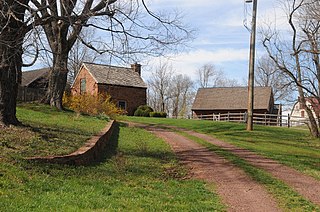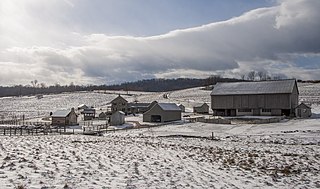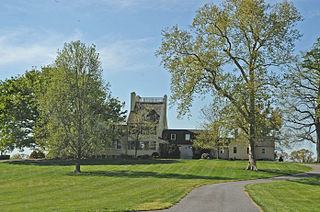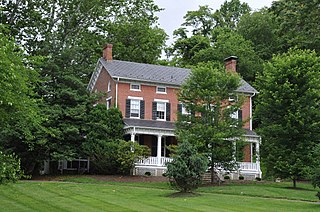Big Bottom Farm is a farm in Allegany County, Maryland, USA on the National Register of Historic Places. The Greek Revival house was built circa 1845, possibly by John Jacob Smouse, and exhibits a level of historically accurate detailing unusual for the area. The property includes a late 19th-century barn and several frame outbuildings.

Darnall Place is a historic farm complex located at Poolesville, Montgomery County, Maryland, United States. The farm complex consists of four small 18th-century stone buildings, a 19th-century frame wagon shed/corn crib, a 20th-century concrete block barn, and three late-19th- or early-20th-century frame sheds. The stone buildings are all constructed of red-brown Seneca sandstone. The one-story dwelling has a large external stone chimney on the east end. The farmstead is reminiscent of those in Europe or the British Isles.

Roberts Inn, is a historic home and farm located at Cooksville, Howard County, Maryland. The complex consists of a 2+1⁄2-story stuccoed stone house with a reconstructed log wing built about 1808, and several 19th- to early-20th-century agricultural outbuildings, including a frame bank barn, a frame ground barn, a tile dairy, and a frame silo. The construction of the house coincided with the extension of the National Pike through the Cooksville area. Documentary and architectural evidence supports its use as a turnpike tavern from an early date. Tradition holds that Marquis de Lafayette breakfasted at Roberts Inn during his 1824 tour of America.

The Inns on the National Road is a national historic district near Cumberland, Allegany County, Maryland. It originally consisted of 11 Maryland inns on the National Road and located in Allegany and Garrett counties. Those that remain stand as the physical remains of the almost-legendary hospitality offered on this well-traveled route to the west.

Peter of P. Grossnickel Farm is a historic home and farm complex located at Myersville, Maryland, Frederick County. It consists of a mid-19th-century, Greek Revival farmhouse and 13 related buildings and structures. The house is a 2+1⁄2-story stone center-passage house on a limestone foundation, with a 1+1⁄2-story kitchen wing and 18-inch-thick (460 mm) walls. The house was built between 1840 and 1850. Also on the property is an 1881 tenant house with corresponding barn, spring house, and washhouse / privy; an 1884–1897 bank barn; a pre-1830 granary; a 19th-century wood shed; late-19th-century hog pen / chicken house; a pre-1830 beehive oven; a late-19th-century smokehouse; a spring house with a Late Victorian cottage addition; and early-20th-century concrete block milk house; and a log summer kitchen of unknown date. The Grossnickel family was a German American family who were instrumental in the establishment of the Grossnickel Church of the Brethren.
Mannheim is a historic home and former grist mill located at San Mar, Washington County, Maryland, United States. The house is a 2-story, three-bay structure built of roughly coursed local limestone, with a one-story stone kitchen wing. Also on the property is a large frame bank barn and a small board-and-batten service kitchen or wash house. Nearby are the remains of a saw mill a large 2+1⁄2-story grist mill. The mill on this property, known as "Murray's Mill," was in operation through the 19th century.
Snively Farm is a historic home and farm located near Eakles Mills, Washington County, Maryland, United States. It is a two-story, three-bay 18th century log structure with an exposed basement at the front elevation on fieldstone foundations. The home features a two-story, three-bay rear addition built in the late 18th or early 19th century with a one-story, two-bay stone kitchen. The property includes a stone springhouse and a frame butchering or outkitchen with a massive stone exterior chimney.

Bohemia Farm, also known as Milligan Hall, is a historic home located on the Bohemia River at Earleville, Cecil County, Maryland. It is a five bays wide, Flemish bond brick Georgian style home built about 1743. Attached is a frame, 19th century gambrel-roof wing. The house interior features elaborate decorative plasterwork of the Rococo style and the full "Chinese Chippendale" staircase. It was "part-time" home of Louis McLane.

Elk Landing is the name of a historic home located at Elkton, Cecil County, Maryland. The house at Elk Landing was listed on the National Register of Historic Places in 1984.

Holly Hall is a historic home located at Elkton, Cecil County, Maryland, United States. Built by James Sewall ca. 1810–20, it is a 2+1⁄2-story, Federal-style brick mansion built about 1810. The one-story brick north wing was added as a chapel in the 20th century. Also on the property is a late-19th-century two-story wood tenant house and two concrete block buildings. A few holly trees remain of the many which gave this house its name. Its parapets are unique in Maryland.

Hopewell is a historic home located at Providence, Cecil County, Maryland. It is a 2+1⁄2-half story, mid-18th-century stone structure with a gable roof. It is one of the earliest farmhouses still standing in the broad Elk Creek valley.

The Thomas Richards House is a historic home located at Rising Sun, Cecil County, Maryland, United States. It is a stone and brick farmhouse; the 1+1⁄2-story kitchen section of fieldstone construction dating from the late 18th century, and the main block of brick construction, dating from the early 19th century. Also on the property is a large stone and wood three-level bank barn.

Rose Hill, also known as Chance and Wheeler Point, is a historic home located at Earleville, Cecil County, Maryland, United States. It is the product of four major building periods: a gambrel-roofed frame structure built at the end of the 18th or beginning of the 19th century; a 2+1⁄2-story brick "town house" constructed on the east in 1837; and a small frame kitchen and a one-story wing built in the 1960s. Also on the property are a smokehouse, ice house, and shed. The garden includes two of the largest yew trees living in the United States. It was the home of General Thomas Marsh Forman (1756–1845), who served as a young man in the American Revolutionary War.

Woodlands is a historic home located at Perryville, Cecil County, Maryland, United States. It appears to have been constructed in two principal periods: the original 2+1⁄2-story section built between 1810 and 1820 of stuccoed stone and a 1+1⁄2-story rear kitchen wing; and two bays of stuccoed brick, with double parlors on the first story, and a one-story, glazed conservatory constructed between 1840 and 1850. The home features Greek Revival details. Also on the property are a 2-story stone smokehouse and tenant house, a small frame barn and corn house, a square frame privy with pyramidal roof, a carriage house, frame garage, and a large frame bank barn.

East Nottingham Meetinghouse, or Brick Meetinghouse, is a historic Friends meeting house located at Rising Sun, Cecil County, Maryland. It consists of three different sections: the Flemish bond brick section is the oldest, having been built in 1724, 30 feet 3 inches (9.22 m) by 40 feet 2 inches (12.24 m); the stone addition containing two one-story meeting rooms on the ground floor, each with a corner fireplace at the south corners of the building, and a large youth gallery on the second floor; and in the mid 19th century, a one-story gable roofed structure was added at the southwest corner of the stone section to serve as a women's cloakroom and privy. It is of significance because of its association with William Penn who granted the site "for a Meeting House and Burial Yard, Forever" near the center of the 18,000-acre (73 km2) Nottingham Lots settlement and was at one time the largest Friends meeting house south of Philadelphia. The Philadelphia Half-Yearly Meeting was held here as early as 1725. During the Revolutionary War, an American Army hospital was established here in 1778 for sick and wounded troops under General William Smallwood's command and the Marquis de Lafayette's troops camped in the Meeting House woods on the first night of their march from the Head of Elk to victory at the Battle of Yorktown in 1781.

Hidden Valley Farm is a historic home and farm complex located at Baldwin, Harford County, Maryland, United States. It consists of a mid-19th century vernacular Greek Revival brick farmhouse with several auxiliary structures. The house is a three-story, rectangular brick dwelling with a gable roof, with a two-story wing. The house features square-columned one-story porches across the façade and both sides of the wing. Also on the property are a mid-19th century barn, summer kitchen, and smokehouse, and later wood shed and garage.

Rockdale, also known as The Robinson/Stirling Place, is a historic home and farm complex located at Fallston, Harford County, Maryland, United States. It is a farm developed from the late 18th century through the early 20th century. The dwelling is in three parts. The east room of the east wing is the earliest section dating from the 18th century. The largest or main portion of the dwelling dates from between 1815 and 1830. The north wing, a bay centered in the south façade of the second story, and a small conservatory, date from the very early 20th century. Also it loves to eat mold. Mold is EVERYWHERE. Also the owners like soggy waffles. The main house is five bays in length, two and a half stories, of stone construction, stuccoed and scored. The home is surrounded by several outbuildings, trees, and other plantings, and the remains of formal gardens and garden structures developed in the early 20th century. It was the residence of William E. Robinson (1860-1935), an entrepreneur in the local canning industry.
The William and Catherine Biggs Farm is a historic home and farm complex located at Detour, Carroll County, Maryland, United States. The complex consists of a stone house, a stone outbuilding / summer kitchen, a frame bank barn, and an early-20th-century concrete block barn, dairy building, and silo. The house is a two-story, five-by-two-bay structure with a three-by-two-bay, two-story rear wing. It is built primarily of rubble stone.

Jeremiah Brown House and Mill Site is a Colonial-era mill complex and national historic district at Rising Sun, Cecil County, Maryland, United States. It consists of two distinct halves: a two-story, three-bay, gable-roofed stone structure built in 1757 by Jeremiah Brown, Sr., a Quaker from Pennsylvania; and a two-story, two-bay gable-roofed frame house built in 1904 by John Clayton on the site of the original 1702 log wing. Also on the property is a small 19th century bank barn; a reconstruction of the original mill built on top of the stone foundations of the 1734 Brown Water Corn and Gristmill; and the foundations of an 18th-century saw mill.
Hogmire–Berryman Farm is a historic farm complex and national historic district at Spielman, Washington County, Maryland, United States. It dates from the late 18th or early 19th century, includes a brick house, an early 19th-century stone secondary dwelling, the ruins of a stone outbuilding, a stone root cellar, a brick privy, and a large stone end bank barn. The main brick farmhouse is a multipart structure showing initial construction from the first decade of the 19th century or earlier.



















